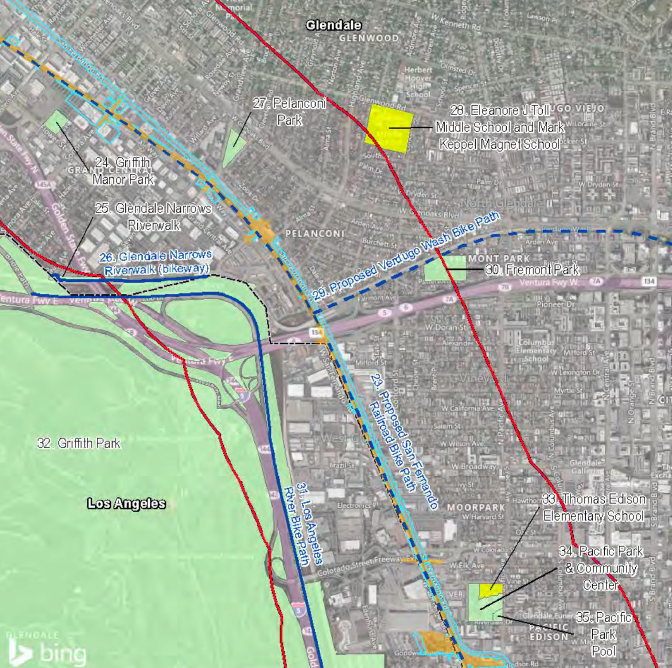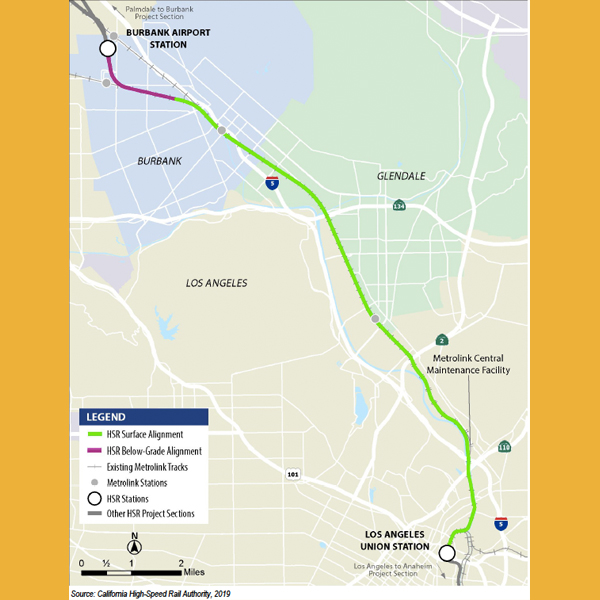Note: GJEL Accident Attorneys regularly sponsors coverage on Streetsblog San Francisco and Streetsblog California. Unless noted in the story, GJEL Accident Attorneys is not consulted for the content or editorial direction of the sponsored content.
The California High-Speed Rail Program crossed a major milestone when its governing board voted to approve the Environmental Impact Report (EIR) and Environmental Impact Statement (EIS) for the fourteen-mile Burbank-to-Los Angeles segment of the California High-Speed Rail Program [PDF] yesterday.
Final environmental documents for the San Jose-to-Merced and San Francisco-to-San Jose segments will be presented for approval this spring and summer. That would leave environmental clearance of two segments remaining: Palmdale-to-Burbank and L.A.-to-Anaheim.
The EIR/EIS analyzed a broad range of potential impacts during construction and final operations of the system. These include transportation, public utilities, air quality, noise and vibration, safety, equity, parks, aesthetics, and cultural resources, among many others. The Authority's team studied local plans to look at existing and planned facilities that might be impacted.
The Burbank-to-Los Angeles segment will add electrified tracks to the existing rail corridor between the Hollywood Burbank Airport and Union Station in downtown LA, providing direct connections to flights, other train routes, and buses. The entire segment will be fully grade separated, with about two miles of the railway in tunnels and five proposed grade separations.
Authority staff pointed out that the CAHSRA has already invested in a number of projects along that segment to prepare existing transit to connect to high-speed rail, including:
- $441 million in the Link Union Station project for pass-through tracks to accommodate HSR trains
- $363 million in shared corridor improvements for other rail operators including Metrolink and the Los Angeles/San Diego/San Luis Obispo Rail Corridor
- $77 million for a grade separation at Rosecrans and Marquardt
- $389 million for connections to the Metro Regional Connector and to Metrolink for upgraded locomotives and to add a Positive Train Control system
During construction, several roads will need to be temporarily closed. The EIR/EIS includes standards for routing traffic, maintaining access, and even requirements for signage during temporary detours. That includes pedestrian, bicycle, and bus access, which must be maintained and supported by contractors on the project. The "Impact Avoidance and Minimization Features" and "Mitigation Measures" listed in the EIR/EIS are considered "binding agreements," according to Serge Stanich, CAHSRA's director of Environmental Services, who presented the documents to the Authority's Board.
Bicycle Impacts
Three planned bicycle paths would be impacted by the project. About one-third of a mile of the planned San Fernando Bike path through Burbank would be blocked - if the path has been built by the time HSR construction begins. Preliminary discussions with the city of Burbank have identified a potential reroute of this path as a protected (Class IV) bikeway along Victory Blvd., if necessary.
A planned extension of the Los Angeles River Bike Path would also be impacted, according to the EIR/EIS, "although exact acreages of impact were not generated because of the multiple alignment options for the path." The Authority would be required to help find an alternative route for the planned extension, maintain connectivity - but if this is done before HSR construction, then it's off the hook.
A bigger problem arises with the planned San Fernando Railroad Bike Path in the city of Glendale. CAHSRA plans to run its trains within the Metro-owned right-of-way there, but the city has plans to build a bike path within that easement. If the path is built before HSR, the Authority would help find and build it an alternative. It's unclear what would happen, however, if the path has not yet been built. The document merely says that "the permanent easement needed for operation of the HSR Build Alternative would preclude the planned San Fernando Railroad Bike Path from being constructed in its current [planned] alignment. If a feasible alternative route is not identified, the loss of the planned San Fernando Railroad Bike Path... may result in a loss of connectivity of the planned bicycle network and change the benefits of the adopted bicycle plans, resulting in an incompatible use."

The HSR alignment was also adjusted to remove impacts to the planned Burbank Western Channel Bike Path and the future Taylor Yard park, and to ensure that the project does not preclude future development of L.A. River Ecosystem Restoration Project.
Other notable bits of information from the document: the project as planned will require taking - displacing - twelve residents and 133 businesses. Seventy residences will experience "severe residual effects" from sound, and the EIR/EIS includes sound walls and other mitigations, such as "noise insulation and double-paned windows."
Also, the document discusses traffic impacts, including Level of Service changes at specific intersections, and even suggests some potential actions to mitigate those changes - mostly by adding lanes and widening intersections. However, it also notes: The LOS "is not applicable to CEQA because LOS is no longer the performance standard for transportation impacts for CEQA."
Airport Not Happy
Lawyers for the Hollywood Burbank Airport and the Department of Water and Power expressed concerns about high-speed rail potentially causing disruptions to their service, with an attorney from the airport going so far as to urge the board members to vote against approval until details had been worked out.
Stanich told board members that those details could not be finalized until after the EIR/EIS was approved, and that the CAHSRA was committing itself to working with all affected agencies to solve issues. The purpose of the EIR/EIS is to do a high-level design overview, he said, and "to identify major conflicts and ways to work out agreements." Staff have been discussing these issues with the FAA and the airport, looking for ways to mitigate any problems as well as to coordinate construction of HSR with the airport's own planned redesign.

The preliminary design for the airport brings the high-speed rail station as close as possible to planned airport terminals without actually being on airport property, and would involve tunneling underneath the runways. Stanich pointed out that tunneling for rail under airports has been safely done at six other airports around the world, and that the current plan would add only one structure - an exit/vent for HSR - that would be about ten feet tall. Concerns about HSR electromagnetic radiation affecting airport communications are being taken seriously, but the rail system uses a different bandwidth that should not interfere with the airport or flight communications, according to Stanich.
Federal environmental law "prohibits advancement of design until you have EIR approval," said Stanich. "As we advance design, we will work with airport to address their concerns. There are additional permits/studies that will need to be done, but we can't move forward until the EIR/EIS is approved."






